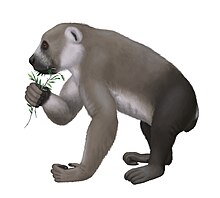Archaeoindris
| Archaeoindris | |
|---|---|
 |
|
| Life restoration of Archaeoindris fontoynontii | |
| Scientific classification | |
| Kingdom: | Animalia |
| Phylum: | Chordata |
| Class: | Mammalia |
| Order: | Primates |
| Suborder: | Strepsirrhini |
| Family: | †Palaeopropithecidae |
| Genus: |
†Archaeoindris Standing, 1909 |
| Species: | †A. fontoynontii |
| Binomial name | |
|
Archaeoindris fontoynontii Standing, 1909 |
|
 |
|
| Subfossil sites for Archaeoindris fontoynontii | |
| Synonyms | |
|
Lemuridotherium madagascariense Standing, 1910 |
|
Lemuridotherium madagascariense Standing, 1910
Archaeoindris fontoynontii is an extinct giant lemur and the largest primate known to have evolved on Madagascar, comparable in size to a male gorilla. It belonged to a family of extinct lemurs known as "sloth lemurs" (Palaeopropithecidae), and because of its extremely large size, it has been compared to the ground sloths that once roamed North and South America. It was most closely related to Palaeopropithecus, the second largest type of sloth lemur. Along with the other sloth lemurs, Archaeoindris was related to the living indri, sifakas, and woolly lemurs, as well as the recently extinct monkey lemurs (Archaeolemuridae). The genus, Archaeoindris, translates to "ancient indri-like lemur", even though it probably became extinct recently, around 350 BCE.
Archaeoindris was first described by Herbert F. Standing in 1909 based on subfossil fragmentary jaws, although Charles Lamberton later discovered a complete skull. Only six bones from the lower skeleton have been found, and excavations in the 1980s offered no leads for new finds. Its remains have been found at only one location: Ampasambazimba, a subfossil site in central Madagascar. Following its initial discovery, some subfossil remains of Megaladapis grandidieri (a type of extinct koala lemur) were mistakenly associated with Archaeoindris, while smaller leg bones from a juvenile and a massive adult leg bone were erroneously assumed to belong to two separate species. These errors were gradually corrected between the 1930s and 1980s. The skeleton of Archaeoindris was massive and robust, and shared many traits with that of Palaeopropithecus. The arms were longer than the legs, but no hand or foot bones have been found for comparison with the other sloth lemurs.
...
Wikipedia
